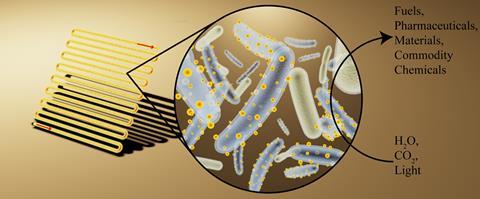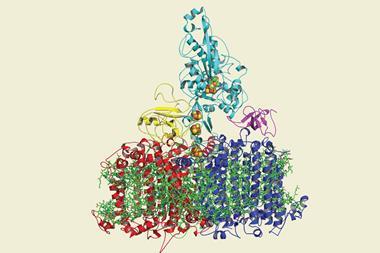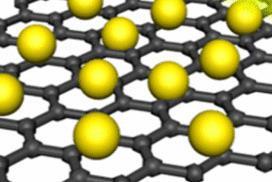Microbes harvest sunlight by coating themselves in cadmium sulfide nanoparticles

A species of bacteria that converts sunlight and carbon dioxide to acetic acid by synthesising its own tiny solar panels is the basis for an artificial photosynthesis system being developed by researchers in the US. With an energy efficiency of around 2% and a quantum efficiency of more than 80%, the bacteria outperform plants when it comes to harvesting the sun’s rays.
‘Our work began when we sort of rediscovered this bacterium, Moorella thermoacetica, which had been studied about 20 years ago, but that hadn’t really gone beyond basic microbiology,’ says Kelsey Sakimoto who is now at Harvard University, but was presenting work he carried out as part of Peidong Yang’s group at the University of California, Berkeley at the 254th American Chemical Society National Meeting and Exposition in Washington DC.
‘In addition to doing CO2 fixation it has a unique feature that if you give it some metal – and in this case we gave it cadmium – it’ll start to precipitate out and synthesise semiconductor quantum dots of cadmium sulfide, which was one of the classic light harvesters in the early days of photovoltaic research.’
The response is thought to have evolved as a defence against toxic metals, but results in the bacterium essentially ‘covering its body in tiny solar panels’, says Sakimoto. ‘If we simply shine light on this system it’s able to fix CO2 into acetic acid,’ he explains. The acetate can then be used as a starting point for a range of other chemicals including fuels, pharmaceutical compounds and bioplastics that can be manufactured by modified strains of E. coli.
Electron eaters
Since the initial discovery, Sakimoto and colleagues have been working to gain a better understanding of how the bacteria function so that the system can be improved. ‘We’ve been [trying to] understand how these bacteria are able to basically eat electrons derived from the semiconductor and some of our recent work has uncovered […] some very nice charge transfer between the semiconductor itself and [hydrogenase] enzymes found on the surface of this bacterium,’ Sakimoto says. ’Now we can begin to tune and tweak the levers and optimise this interface, and develop more functional systems from that.’
By growing the bacteria in tube-shaped reactors that are exposed to a light source, and giving them the sulfur-containing amino acid cysteine as an additional food source, Sakimoto and colleagues have shown they can achieve efficiency levels that make them ‘better than natural photosynthesis’.
Their set-up has advantages over approaches that use purified enzymes coupled to semiconductors, Sakimoto says, as it is stable and self-replicating. The cadmium they put in does not get used up because when cells die, neighbouring bacteria feed on them and repurpose the metal.
A very lofty target
The plan is to eventually commercialise the system, although there are still some improvements to be made. ‘We expect the upper ceiling of [the efficiency] we could achieve is much greater,’ Sakimoto says. ‘One thing we’re quite interested in is trying to find other semiconductors that can be produced through this biosynthetic route […] things like silicon or next-generation solar panel materials like indium phosphide.’
To do this, he says, researchers will have to start looking for new bacterial species in ‘unusual’ environments where they might encounter these more advanced materials, such as laboratories or clean rooms within factories where there is a high abundance of these elements. ‘Wherever you have a surface and mild conditions, you’re bound to find bacteria. So bioprospecting in these common but exotic environments would yield bacteria that can produce more interesting types of semiconductors.’
Another possible avenue is to use synthetic biology to introduce new metabolic pathways into the bacteria, so the acetate they produce by photosynthesis can be immediately processed into useful products. ‘Finding a way to translate a very chemical reaction into some sort of biological machinery is a very, very lofty target, but one that we are actively pursuing,’ Sakimoto says.

















No comments yet